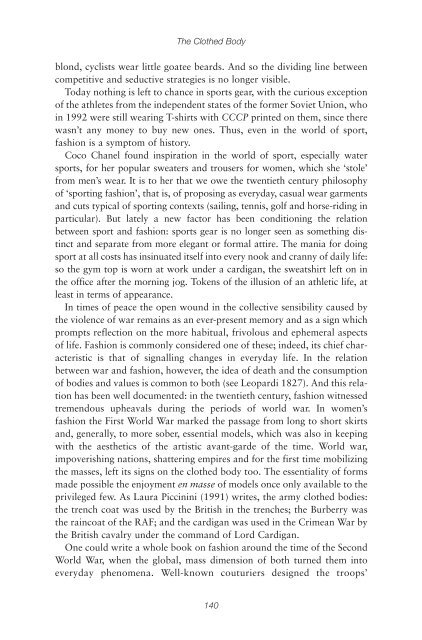Create successful ePaper yourself
Turn your PDF publications into a flip-book with our unique Google optimized e-Paper software.
<strong>The</strong> <strong>Clothed</strong> <strong>Body</strong><br />
blond, cyclists wear little goatee beards. And so the dividing line between<br />
competitive and seductive strategies is no longer visible.<br />
Today nothing is left to chance in sports gear, with the curious exception<br />
of the athletes from the independent states of the former Soviet Union, who<br />
in 1992 were still wearing T-shirts with CCCP printed on them, since there<br />
wasn’t any money to buy new ones. Thus, even in the world of sport,<br />
fashion is a symptom of history.<br />
Coco Chanel found inspiration in the world of sport, especially water<br />
sports, for her popular sweaters and trousers for women, which she ‘stole’<br />
from men’s wear. It is to her that we owe the twentieth century philosophy<br />
of ‘sporting fashion’, that is, of proposing as everyday, casual wear garments<br />
and cuts typical of sporting contexts (sailing, tennis, golf and horse-riding in<br />
particular). But lately a new factor has been conditioning the relation<br />
between sport and fashion: sports gear is no longer seen as something distinct<br />
and separate from more elegant or formal attire. <strong>The</strong> mania for doing<br />
sport at all costs has insinuated itself into every nook and cranny of daily life:<br />
so the gym top is worn at work under a cardigan, the sweatshirt left on in<br />
the office after the morning jog. Tokens of the illusion of an athletic life, at<br />
least in terms of appearance.<br />
In times of peace the open wound in the collective sensibility caused by<br />
the violence of war remains as an ever-present memory and as a sign which<br />
prompts reflection on the more habitual, frivolous and ephemeral aspects<br />
of life. Fashion is commonly considered one of these; indeed, its chief characteristic<br />
is that of signalling changes in everyday life. In the relation<br />
between war and fashion, however, the idea of death and the consumption<br />
of bodies and values is common to both (see Leopardi 1827). And this relation<br />
has been well documented: in the twentieth century, fashion witnessed<br />
tremendous upheavals during the periods of world war. In women’s<br />
fashion the First World War marked the passage from long to short skirts<br />
and, generally, to more sober, essential models, which was also in keeping<br />
with the aesthetics of the artistic avant-garde of the time. World war,<br />
impoverishing nations, shattering empires and for the first time mobilizing<br />
the masses, left its signs on the clothed body too. <strong>The</strong> essentiality of forms<br />
made possible the enjoyment en masse of models once only available to the<br />
privileged few. As Laura Piccinini (1991) writes, the army clothed bodies:<br />
the trench coat was used by the British in the trenches; the Burberry was<br />
the raincoat of the RAF; and the cardigan was used in the Crimean War by<br />
the British cavalry under the command of Lord Cardigan.<br />
One could write a whole book on fashion around the time of the Second<br />
World War, when the global, mass dimension of both turned them into<br />
everyday phenomena. Well-known couturiers designed the troops’<br />
140

















